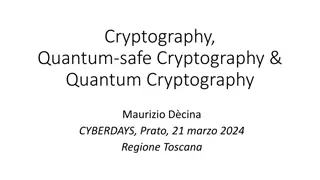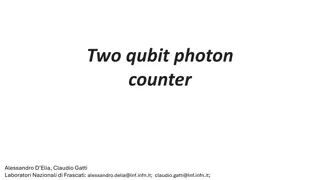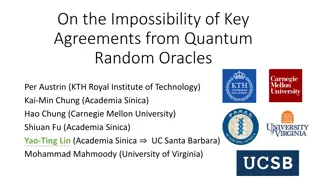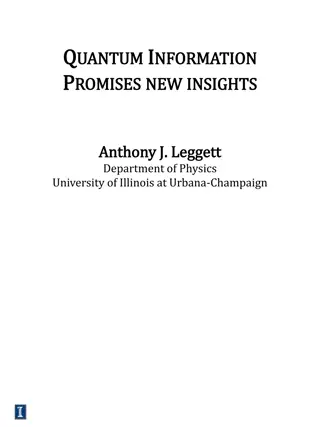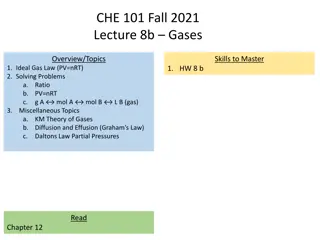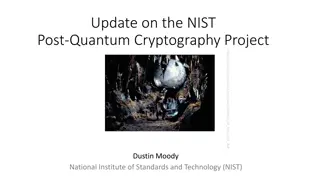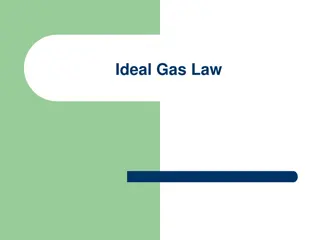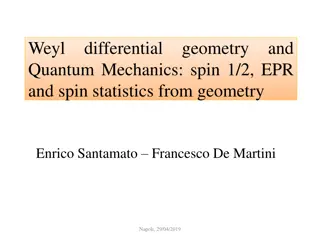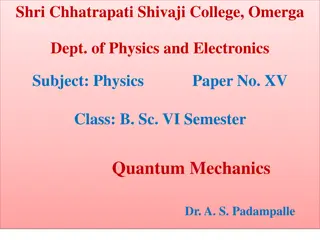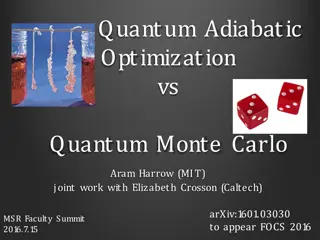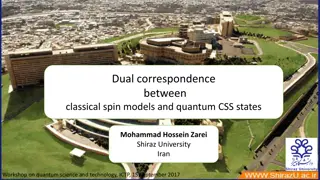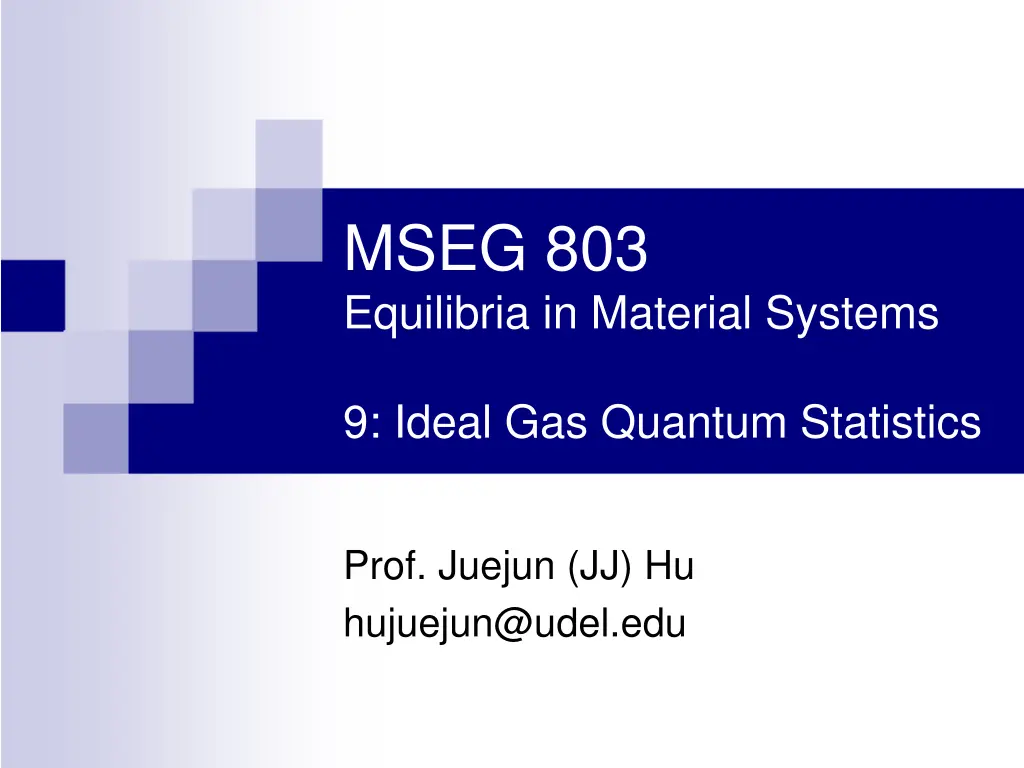
Equilibria in Material Systems: Ideal Gas Quantum Statistics
"Explore the ideal gas quantum statistics including classical and quantum statistics, distributions, and microscopic states of particles in material systems. Understand the different behaviors of bosons and fermions based on Pauli exclusion principle and spin. Delve into the classical Maxwell-Boltzmann distribution and methods of deriving distribution functions in material systems."
Download Presentation

Please find below an Image/Link to download the presentation.
The content on the website is provided AS IS for your information and personal use only. It may not be sold, licensed, or shared on other websites without obtaining consent from the author. If you encounter any issues during the download, it is possible that the publisher has removed the file from their server.
You are allowed to download the files provided on this website for personal or commercial use, subject to the condition that they are used lawfully. All files are the property of their respective owners.
The content on the website is provided AS IS for your information and personal use only. It may not be sold, licensed, or shared on other websites without obtaining consent from the author.
E N D
Presentation Transcript
MSEG 803 Equilibria in Material Systems 9: Ideal Gas Quantum Statistics Prof. Juejun (JJ) Hu hujuejun@udel.edu
Ideal gas: systems consisting of particles with negligible mutual interactions Classical ideal gas (Maxwell-Boltzmann MB statistics) All particles are distinguishable Quantum statistics Indistinguishable particles: interchanging two particles does not lead to a new state Particles with integral spin (Bosons in Bose-Einstein BE statistics) Particles with half-integral spin (Fermions in Fermi-Dirac FD statistics): one single particle state can only be occupied by one particle (Pauli exclusion principle)
Microscopic states of ideal gas systems Example: a 2-particle system with 3 single particle states Single particle states are different from microscopic states of a multi-particle system! MB Statistics BE Statistics FD Statistics State 1 AB State 2 State 3 State 1 AA State 2 State 3 State 1 A State 2 A State 3 AB AA A A AB AA A A A B A A B A A A A B A A B A There is a greater tendency for particles to bunch together in the BE case A B B A
Classical case: Maxwell-Boltzmann distribution Take an individual system in a canonical ensemble as one single classical ideal gas particle. The probability of finding the particle in a specific single-particle level with energy Er (in this case also the energy level of the system) is given by the canonical probability distribution function: E 1 Z e r = = E P e r r E e r r Assumptions: no interactions between particles (ideal gas), all particles are distinguishable
Two methods of deriving distribution functions Model the systems as canonical ensembles Calculate average particle # which minimizes Z Calculate partition function Z Fix temperature Model the systems as micro-canonical ensembles Calculate average particle # which maximizes Fix internal energy Calculate # of states
Quantum statistics: problem formulation Quantum states/levels of a single particle: r, s Energy of single particle levels r or s: ror s Number of particles in state r or s: nror ns Quantum state of the entire ideal gas system: R Energy of the system in state R : ... R E n n n = + + + = n 1 1 2 2 3 3 r r r Canonical partition function: ( exp R ) ( ) = = 1 1 n + + 3 3 n + exp ... Z E n 2 2 R R Mean number of particles in a single particle state r : 1 exp r r R Z 1 ln Z ( ) = 1 1 n + + 3 3 n + = ... n n n 2 2 r
Fermi-Dirac distribution ; define: N = n ns = 0 or 1, ( ) r Z N s s exp ( ) = 1 1 n + + + + ( ) r ... ... n n + + 1 1 1 1 r r r r R ( ) 1 1 n + + exp ... n n ( ) + 0 ( ) exp + ( Z N 1) Z N 2 2 r = = r r n R ( ) ( ) r 1 1 n + + exp ( 1) Z N exp ... n r r r 2 2 R ln Z ln Z ( ) ( ) N ( ) ( ) N = = ln 1 ln Z N Z r 1 exp Z N Z r r r r r N N ln ln N Z Z In macroscopic systems: = ~ r N ( exp ) exp ( ) Z N ( 1) ( Z N 1 = = r r n ( ) ( ) r + + 1 ) Z N ex p 1 r r r r
Fermi-Dirac distribution: alternative derivation The different number of ways to distribute ni particles over gi degenerate sub-levels of an energy level i: ! ! ! i i i n g n g = i ( ) i The total number of ways the set of occupation numbers { ni } can be realized: ! ! ! i i i i i n g n g = = i ( ) i Maximizing subjected to the constraints: i i i = = n N n E i 1 n g = = i n i ( ) r + exp 1 = = ln ln 0 d d i i i i
Partition function of Fermion ideal gas ( ) ( ) = = 1 1 n + + 3 3 n + ( ) Z N exp exp ... E n 2 2 R R R = n N Constraint: r r ( ) ( ) = ' exp Define N sharply peaking at N = N ' Z N N ' ( ) ( ) = + + exp exp ... n n 1 1 2 2 = = 0,1 0,1 n n 1 2 ( ) 1 exp + = r r ( ) ( ) = ln ' exp N ' Z N N lnZ N ln N Z = = = 0 ' ( ) Z N ( ) ln ~ ln exp ~ ln N N Z N ( ) ln 1 exp + = + = + ln ln Z N N r r
Properties of Fermi-Dirac distribution At T = 0 K, FD distribution is a step function and the chemical potential defines the Fermi surface Electrons in metals When distribution can be approximated by the classical MB distribution Electrons in the conduction band of semiconductors or insulators , FD kT r
Bose-Einstein distribution ( = n N nr can be any positive integer, ( ( ( ( ) 0 exp ( ) 0 exp r Z N = r r ) ) + + + 0 exp ( 1) 2 exp 1) + 2 ( 2) ... 2) ... Z N Z N = r r r r Z N n ) ( ) 2 r + + ( ) exp ( exp 2 ( Z N Z N r r r r r ) ( ) + + + + + + + 2 exp exp + 2 ... Z N r r r + = ( ) ( ) + 2 2 ... r r ( ) exp n n r 1 = n ( ) ( ) exp exp 1 n r r n = n N Chemical potential is determined by For a system comprised of conservative Bosons, is always lower than any single-particle energy level Partition function: ln Z N = r r ( ) ln 1 exp r r
Bose-Einstein condensate (BEC) At low temperature, Bosons tends to cluster at the lowest energy quantum mechanical state Velocity-distribution data of a gas of Rb atoms. Left: just before the appearance of BEC. Center: just after the appearance of BEC. Right: nearly pure BEC.
Photon statistics (Planck statistics) Photons are Bosons The total number of photons is NOT conserved: = 0 In equilibrium: 0 dG SdT VdP dN = + + = = 0 dN 0 1 1 = = n ( ) ( ) r exp 1 exp 1 h r Note that the condition = 0 only applies to photons in thermal equilibrium with a blackbody!
Statistics of blackbody radiation Blackbody: an idealized physical body that absorbs all incident electromagnetic radiation Wave vector quantization condition: = L Z+ k n x n x x L 2 2 2 2 = + + = + + 2 2 2 k k k k n n n x y z x y z L Photon energy: 2 c = = = + + 2 2 2 E kc n n n x y z L
Statistics of blackbody radiation (contd) The volume each state occupies in the phase space: L ky E + dE 3 3 3 1 2 = = = E V state 3 2 2 L L V Photon Density of States (PDOS): kx E c ( ) 2 4 E V c dk 1 8 ( ) E dE = state ( ) 2 4 E c 2 1 8 dE VE = = dE 3 2 3 3 c 2 V c
Statistics of blackbody radiation (contd) Total # of photons with energy between E to E + dE : 2 1 VE ( ) E dE = n dE ( ) r 2 3 3 c exp 1 E Total number of photons with frequency between to + d per unit volume: ( ) 3 3 exp 1 h h c 2 V h 8 2 1 8 1 kT ( ) = d h d ( ) e 3 h 1 c Total energy of photons having frequencies between to + d per unit volume: 8 1 , 1 c e 3 h ( ) = u T d d 3 h kT
Plancks law and the Stefan-Boltzmann law Blackbody spectral irradiance: 3 8 1 h ( ) = , u T d d ( ) 3 exp 1 c h Total energy emitted from a blackbody per unit area per unit time: ( ) I T ( ) = , u T d 0 5 4 8 15 k = = 4 4 T aT 3 3 c h a = 7.57 10-16 J m-3 K-4
Heaven is hotter than Hell a thermodynamic proof The Bible, Isaiah 30:26: Moreover, the light of the moon shall be as the light of the sun and the light of the sun shall be sevenfold as the light of seven days. ( ) 7 7 1 heaven earth T T = + = 4 50 ~ 525 heaven T C The Bible, Revelations 21:8: But the fearful and unbelieving... shall have their part in the lake which burneth with fire and brimstone. A lake of sulfur (brimstone): T T C ,~ 445 S b hell Appl. Opt. 11(8), A14 (1972).
Classical limit of quantum distribution ( ) In a dilute ideal gas, = ( ( exp rn exp 1 n r r ( ( ) ( ) ) = = = exp exp exp n N r r r r r r ) exp N = = r ln kT n N ( ) ) r exp r r r r Partition function ln Z = ( ) + = + + ln ln exp N N N N N N r r Maxwell-Boltzmann partition function = = = ln ln ln ( ln ) ln ln ! ln Z N e Z N N N Z N Z r MB r
Thermodynamic properties of ideal gas: MB classical treatment 2 p = = Internal energy of monatomic gas: E kinetic E 2 m N 3 3 ... 1 m d q d p ... exp = 2 1 h N Z p MB 3 N 2 N 0 1 = ... ... 2 3 2 3 3 3 exp exp p d p p d p d q d q 1 1 1 N N N 3 N 2 2 h m m 0 N 3 2 N N 2 h V h m = = = 2 3 N exp p d p V 3 2 N 2 m 0 0 3 2 3 2 2 m Single molecule partition function : = + ln ln ln ln Z N V MB 2 h 0
Thermodynamic properties of ideal gas: MB classical treatment (cont d) 3 2 3 2 2 m = + Partition function: ln ln ln ln Z N V MB 2 h 0 ln 1 1 Z V N V NkT V Pressure: = = = P MB Ideal gas equation 3 2 ln 3 2 3 2 Z N Internal energy: = = = = Vc R E NkT MB 3 2 ( ) Entropy: = + = + + ln ln ln S k Z E Nk V T 0 MB MB 3 2 2 3 2 mk where = + ln 0 2 h 0
Thermodynamic properties of ideal gas: classical limit of quantum statistics Partition function: ( ) = + + ln ln ln exp Z N N N N r r N 3 2 3 2 2 V N m = = + + ln ln ln 1 Z N 2 ! N h ln 3 2 3 2 Z N Internal energy: = = = E NkT 3 2 V N ( ) Entropy: = + = + + ln ln ln S k Z E Nk T 3 2 2 5 2 3 2 mk h where = + = + + ln ln ln S Nk V T S MB 2
Gibbs paradox Mixing two parts of ideal gas of identical composition Maxwell-Boltzmann statistics = 3 2 Before mixing: + + 2 ln ln S Nk V T , MB i 3 2 ( ) After mixing: = + + 2 ln 2 ln S Nk V T S , , MB f MB i Quantum statistics in the classical limit 3 2 V N Before mixing: = + + 2 ln ln S Nk T 0 i 3 2 V N After mixing: = + + = 2 ln ln S Nk T S 0 f i
Vapor-solid phase equilibrium = Equilibrium condition: s v N Partition function of vapor: = Z Different from MB ! v ! N Chemical potential of vapor: = 3 2 ln N 2 F N Z kT P mkT h = = ln v v kT kT v 2 v v , T V Chemical potential of solid: = ln N F N Z = s s kT s s s , T V ln ln Z Z E kT T ( ) T = = 2 s s E kT = ln ln s Z Z dT s 0 s s T 2 T 0
Vapor-solid phase equilibrium (contd) Chemical potential of solid: T ( ) ( ) c T dT = + E E T N 0 s s s T 0 ( ) k E T 1 T 1 T dT kT T T ( ) T ( ) = 0 + + s ln ln Z Z N c T dT 0 s s s 2 T T 0 0 0 ( ) kT ( ) kT F T E T ( ) T ( ) = = 0 0 s s ln Z 0 T K 0 s 0 0 0 ( ) kT E T dT kT ( ) E T N T T ( ) = + 0 s ln Z N c T dT s s 2 T T 0 0 ln N Z dT kT T T ( ) = = 0 s s kT T c T dT s 2 T T 0 0 s s
Vapor-solid phase equilibrium (contd) = Equilibrium condition: s v ( ) N 3 2 E T 2 kT P mkT h dT kT T T ( ) = 0 s ln kT T c T dT 2 2 T T 0 0 s Equilibrium vapor pressure: ( ) kTN 3 2 E T 2 1 k mkT h dT kT T T ( ) = 0 + s exp P kT c T dT 2 2 T T 0 0 s Saturated vapor (equilibrium): the rate of molecules impinging on the solid/liquid surface = the rate of vaporization from solid/liquid
Density of states for single-particle levels Consider ideal gas occupying a volume V Plane wave solution time-independent Schr dinger equation: ( exp A ik r p k = ) 2 2 k m Lx = = 2 Periodic boundary condition: ( ) ( x x = + ) L x 2 L Quantization of wave vector k : Density of states: Z+ = k n x n x x x ( ) 3 3 2 2 V m V ( ) k ( ) = 3 = d k 1 2 d ( ) 3 2 4 2

